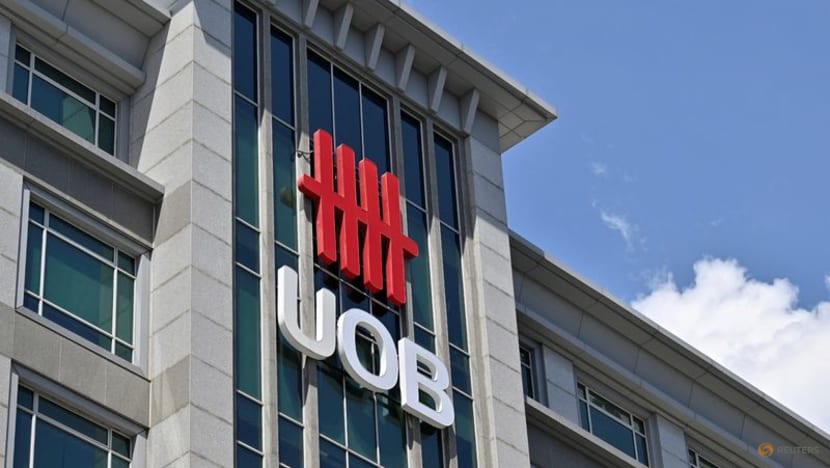UOB joins OCBC in cutting interest rates for savings accounts from May 1
The move by UOB follows a similar one by OCBC, with both banks saying there is a need to be in line with market conditions.

FILE PHOTO: A view of the United Overseas Bank (UOB) signage in Singapore on May 3, 2023. REUTERS/Caroline Chia/File Photo

This audio is generated by an AI tool.
SINGAPORE: United Overseas Bank (UOB) will be cutting the interest rates for its flagship savings account from May 1 to âalign with long-term interest rate environment expectationsâ.
The move comes hot on the heels of a similar move announced by OCBC last week.
Flagship savings accounts offered by banks typically provide tiered interest rates that go up as customers grow their account balance, spend a minimum on select cards and conduct other transactions with the bank such as taking up a housing loan.
In late 2022, the banks made aggressive hikes to the interest rates offered to savers in the midst of a rising rate environment.
However, that changed as expectations built up for central banks to start cutting rates, with UOB making the first move to trim interest rates last May.
With the latest move, the tiered interest rates for UOB One account holders with balances of up to S$150,000, credit their salary to the bank and meet a minimum spend of S$500 a month on an eligible bank card will range from 2.3 per cent to 5.3 per cent.
This translates to a maximum effective interest rate of 3.3 per cent, based on a notice posted on its website on Tuesday (Apr 1).
These rates are down from the current range of 3 per cent to 6 per cent, and a maximum effective interest rate of 4 per cent for the same qualifying conditions.
In a media statement, UOB said while it is revising the One account's interest rates, it has kept the qualifying criteria for bonus interest unchanged.
"We have also retained the eligible balance of S$150,000 to earn the highest effective interest rate," said head of group personal financial services Jacquelyn Tan.
A downward revision in interest rates is also in store for OCBCâs 360 account holders from May 1.
In an email to customers on Mar 24, OCBC noted that âinterest rates have been lower this past yearâ so it is making the changes to be âin line with prevailing market conditionsâ.
The change means that customers will earn a maximum effective interest rate of 6.3 per cent a year on the first S$100,000 in their account when they credit their salary, save, spend, as well as take up investment and insurance products with the bank.
This is down from the current 7.65 per cent.
For now, other banks have not announced any changes to their flagship savings accounts.
In response to Â鶹âs queries, DBS would only say that the bank âremains steadfast in (its) commitment to helping customers build and manage their wealth effectivelyâ.
Currently, its Multiplier account offers a maximum interest rate of up to 4.1 per cent a year for the first S$100,000 in deposits, if customers credit their salary to the bank and transact in three categories with a total volume of S$30,000 or more a month.
However, one observer said that it might not be long before other banks follow suit, especially as the United States Federal Reserve is set to remain on a rate-cut trajectory.
Phillip Securitiesâ senior financial services manager Elijah Lee said:Â âI would expect most banks to be in line with each other as the market for customer deposits is quite competitive, that is why UOB made its own move to cut after OCBC's announcement.
âAll it takes is one bank to make a major move and there's a strong chance that others will follow.â
With that, customers thinking of switching savings accounts should think twice.
âThe rates could be cut further within a short time and account holders will have to go through the whole exercise of evaluating the best option again,â Mr Lee added.
The US Fed cut interest rates three times last year and is expected to do so again this year, especially as US President Donald Trumpâs tariffs policies fuel the risk of a recession in the worldâs largest economy.
The uncertainty of further tariffs that could be imposed on more countries have already jolted markets and hammered equities across the board this week.
Mr Lee also said: âTrumpâs tariff plans definitely have kept the market on edge and with plans for him to announce more tariffs, depending on the scale and severity of the tariffs, the pace of the rate cuts may be sped up if markets react negatively.â
Goldman Sachs' analysts have raised their 12-month recession probability for the US economy from 20 per cent to 35 per cent. They also see the Fed cutting rates in July, September and November, as opposed to earlier bets on two cuts this year and one in 2026.
Swiss private bank Julius Baerâs chief economist David Kohl said: âHigher tariffs have a tax-like effect on incomes and hence on US (economic) growth. And tighter financial conditions due to market jitters add another headwind to growth.â
Julius Baer has lowered its 2025 growth forecast for the US to 2 per cent, alongside a slight increase in the countryâs unemployment rate to 4.4 per cent by the end of the year.
Mr Kohl added that tariffs will likely push up inflation to 3.5 per cent this year, but the Fed is set to âignore the temporary increaseâ and cut rates in response to a cooling labour market.












